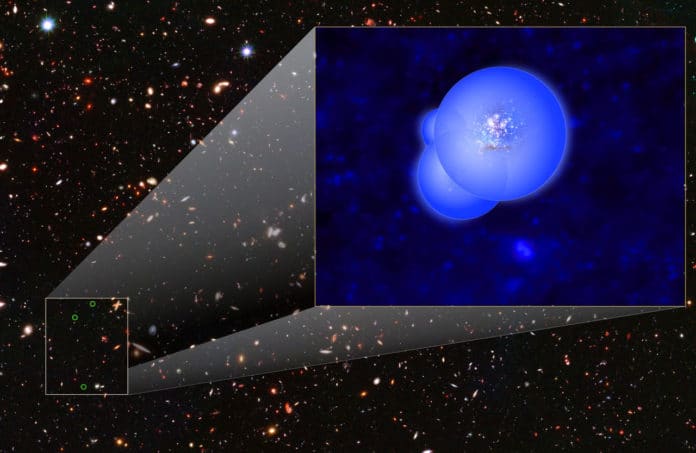An international team of astronomers has recently identified the farthest galaxy group called EGS77. EGS77 is located 13 million light-years away from the Earth and dates to a time when the universe was only 680 million years old, or less than 5% of its current age of 13.8 billion years.
Detailed observations suggest that the trio of galaxies- actually participants of a sweeping cosmic makeover called reionization. The era started when light from the first stars changed the nature of hydrogen all through the universe in a way much the same as a frozen lake melting in the spring. This changed the dark, light-quenching early cosmos into the one we see around us today.
EGS77 was discovered as part of the Cosmic Deep And Wide Narrowband (Cosmic DAWN) survey, for which Rhoads serves as principal investigator. The team imaged a small area in the constellation Boötes using a custom-built filter on the National Optical Astronomy Observatory’s Extremely Wide-Field Infrared Imager (NEWFIRM), which was attached to the 4-meter Mayall telescope at Kitt Peak National Observatory near Tucson, Arizona.
Since the universe is expanding, Lyman alpha light from EGS77 has been stretched out during its travels, so astronomers identify it at near-infrared wavelengths. We can’t see these galaxies in visible light now since that light began at shorter wavelengths than Lyman alpha and was scattered by the haze of hydrogen atoms.
Scientists used Multi-Object Spectrometer for Infra-Red Exploration (MOSFIRE) on the Keck I telescoped at the W. M. Keck Observatory on Maunakea, Hawaii and confirmed the distance to EGS77’s galaxies. The three galaxies all show Lyman alpha emanation lines at slightly different wavelengths, reflecting somewhat various separations. The division between adjacent galaxies is about 2.3 million light-years, or marginally closer than the distance between the Andromeda galaxy and our own Milky Way.
Co-author Sangeeta Malhotra at Goddard said, “While this is the first galaxy group identified as being responsible for cosmic reionization, future NASA missions will tell us much more. The upcoming James Webb Space Telescope is sensitive to Lyman alpha emission from even fainter galaxies at these distances and may find more galaxies within EGS77.”
The paper describing the discovery is published in The Astrophysical Journal.
